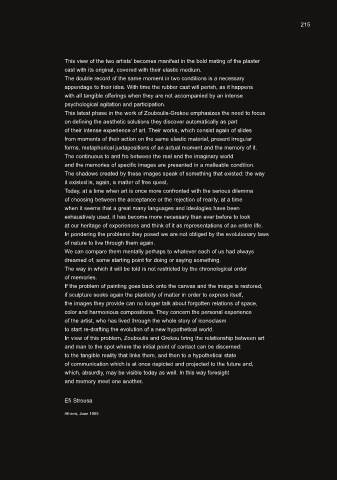Page 217 - 1o ZOUa4.ps
P. 217
FINAL 9:FINAL 9.qxd 23/7/2009 7:49 μμ Page 7
215
This view of the two artists' becomes manifest in the bold mating of the plaster
cast with its original, covered with their elastic medium.
The double record of the same moment in two conditions is a necessary
appendage to their idea. With time the rubber cast will perish, as it happens
with all tangible offerings when they are not accompanied by an intense
psychological agitation and participation.
This latest phase in the work of Zouboulis-Grekou emphasizes the need to focus
on defining the aesthetic solutions they discover automatically as part
of their intense experience of art. Their works, which consist again of slides
from moments of their action on the same elastic material, present irregular
forms, metaphorical juxtapositions of an actual moment and the memory of it.
The continuous to and fro between the real and the imaginary world
and the memories of specific images are presented in a malleable condition.
The shadows created by these images speak of something that existed: the way
it existed is, again, a matter of free quest.
Today, at a time when art is once more confronted with the serious dilemma
of choosing between the acceptance or the rejection of reality, at a time
when it seems that a great many languages and ideologies have been
exhaustively used, it has become more necessary than ever before to look
at our heritage of experiences and think of it as representations of an entire life.
In pondering the problems they posed we are not obliged by the evolutionary laws
of nature to live through them again.
We can compare them mentally perhaps to whatever each of us had always
dreamed of, some starting point for doing or saying something.
The way in which it will be told is not restricted by the chronological order
of memories.
If the problem of painting goes back onto the canvas and the image is restored,
if sculpture seeks again the plasticity of matter in order to express itself,
the images they provide can no longer talk about forgotten relations of space,
color and harmonious compositions. They concern the personal experience
of the artist, who has lived through the whole story of iconoclasm
to start re-drafting the evolution of a new hypothetical world.
In view of this problem, Zouboulis and Grekou bring the relationship between art
and man to the spot where the initial point of contact can be discerned:
to the tangible reality that links them, and then to a hypothetical state
of communication which is at once depicted and projected to the future and,
which, absurdly, may be visible today as well. In this way foresight
and memory meet one another.
Efi Strousa
Athens, June 1980

